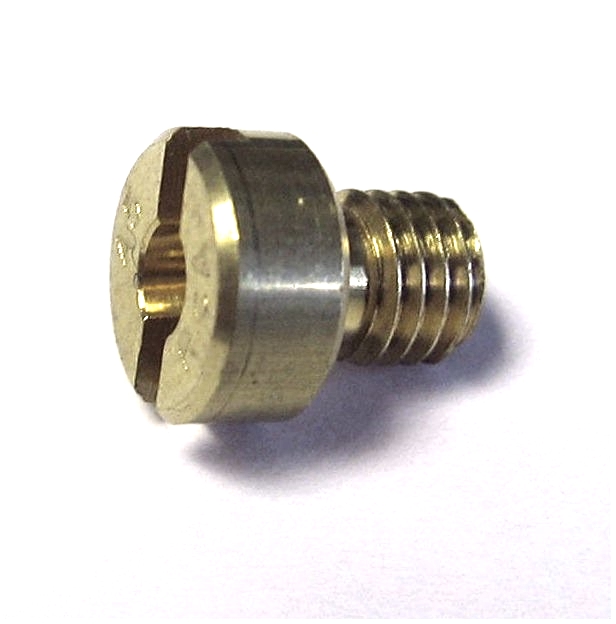From a website:
The standard carburetor with standard jetting as originally furnished on your car is usually the most economical and dependable. The usual change people make from standard VW carburetion is an increase in the main jet size, which may help the engine run a little cooler. Main jet sizes run through a range from X110 to X150 (1.1 - 1.5mm diameter).
(The jets are made in 2.5 increments, so it goes X127.5, X130, X132.5, X135 etc. The jet has the size stamped on it, which you may or may not be able to read without a magnifying glass.)
So how do you know which to use? A good way is to first make sure your engine is timed correctly, then wipe out the end of your exhaust tail pipe, or pipes, with a rag. Run about 100 miles and then look at the tail pipe. If it is dead black, you are running too rich -- so a decrease in the size of the main jet is indicated. If the color of the deposit is tan or brown, you are running too lean and the main jet size should be increased. If the color is rich grey, you're about right. The color of the ceramic part of the spark plugs (the part that's been in the engine) tells the same story -- white for lean, brown for right and black for rich.
*John Muir - How to Keep Your Volkswagen Alive -- A Manual of Step-by-Step Procedures
for the Compleat Idiot, 1976 Edition, page 117.
Rob wrote in this regard - See our article on Reading Spark Plugs. The center electrode should look quite clean and grey/white. There should be a light smooth coating of carbon on the rim of the threaded part, and a colour change on the outer electrode of grey (at the tip) to black (where it attaches to the rim of the threaded part), with the change of colour on the corner of the bend. All this indicates a good mixture and correct heat range.
Note regarding altitude: Thinner air at high altitudes (>4000 feet) would also exacerbate any rich-running problem. An altitude of 5000 feet is roughly equivalent to a one size main jet difference. For example, the X130 main jet is a tad rich for the vacuum dizzy at sea level, so if the car is to be operated at a high altitude you might get a smoother engine and less exhaust soot with an X127.5 or even an X125 main jet (the "right" size for 5000 feet altitude).
The 1200cc engines usually used a X120 or X122.5 in the 28PICT carburetors, the 1300cc engines used either X122.5 or X125 in the 30PICT carburetors, the 1500cc engines usually used a X125, and the 1600cc engines usually need a X127.5 in either 30PICT or 34PICT, but MIGHT get away with an X125 in the smaller 30PICT.
Rob notes -- I have a 1500cc single port engine with it's original 30PICT/2 carburetor. The carburetor has a 55 idle, X125 main and 125 air correction jet. I've used this particular carburetor with a 1600cc dual port engine and it works fine with the same main jet, but seems to like a fractionally larger X130 air correction jet (it runs a little rich with the X125 air correction jet). Others might find that the 30 sized carburetor on a 1600cc engine works better with a larger X127.5 main jet. There is enough variation in fuel types, wear and tear on engine and carburetor, altitude and so on that you might need to experiment a little. All suggestions here are just that - suggestions.
When you work out the area of the hole in each jet, the steps are roughly 2% increase in fuel flow for each size up (X125 to X127.5 for example). But engine sizes have much more variation, 1200cc to 1300cc is about 8% more, 1300cc to 1500cc is nearly 14% more, and 1500cc to 1600cc is about 7% more. You'd think the jet sizes would follow the capacity more closely, but they don't.
All Solex carburetors tend to run lean at high power settings (high rpm and open throttle). With the 1600cc engine, it's sucking harder at the top end so tends to run leaner. This means that the main jet is sized to the engine capacity, rather than the carburetor size, and X127.5 is the usual minimum for the 1600cc engine.
Bentley (page 20 of the 'fuel' section -- table of 'carburetor setting and jets') says the X130 was normal for '71-'72 34PICTs, and X127.5 was normal for '73-'74s (non-California models). We have heard it said that the X130 (or X127.5) is a tad on the lean side, and the X132.5 gives a fractionally rich mix (which VWs have always liked better than lean).
The X127.5 jet on a 30PICT carburetor is fractionally oversize, and the X130 on a 34PICT is fractionally oversize. As indicated previously, the VW engine actually runs better at fractionally rich settings (ideally 13.8:1 rather than 14.5:1), but they are usually jetted a little leaner than that, so the X127.5 is really a minimum jetting for the 1600cc engine.
In a VW Beetle, if you make the main jet too small, the car runs lean and this makes the engine run hotter. Because the aircooled engine runs hot anyway, the smaller jet in the carburettor can make too much heat and burn the exhaust valves. You can also get detonation (pinging/knocking) if the engine gets too hot.
...sounds a bit big?
![Image]()






